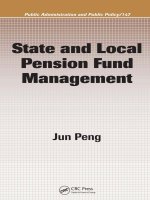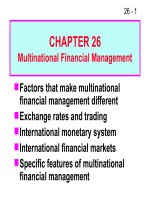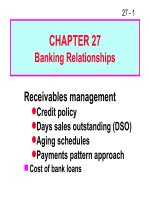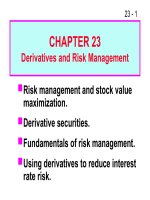FM11 Ch 29 Pension Plan Management
Bạn đang xem bản rút gọn của tài liệu. Xem và tải ngay bản đầy đủ của tài liệu tại đây (80.59 KB, 32 trang )
29 - 1
Pension plan terminology
Defined benefit versus defined
contribution plans
Pension fund investment tactics
Retiree health benefits
CHAPTER 29
Pension Plan Management
29 - 2
They constitute the largest class of
investors.
They hold about 33% of all U. S.
stocks.
How important are pension funds?
29 - 3
Defined benefit plan: Employer agrees
to give retirees a specific benefit,
generally a percentage of final salary.
Defined contribution plan: Employer
agrees to make specific payments into
a retirement fund, frequently a mutual
fund. Retirees’ benefits depend on the
investment performance of their own
fund. 401(k) is the most common type.
Pension Plan Terminology
(More )
29 - 4
Profit sharing plan: Employer
payments vary with the firm’s profits.
(Defined contribution, but as a
percentage of profits).
Cash balance plan: Employer
promises to put a specified
percentage of the employee’s salary
into the plan, and to pay a specified
return on the plan’s assets.
(More )
29 - 5
Vesting: Gives the employee the
right to receive pension benefits at
retirement even if he/she leaves the
company before retirement.
Deferred vesting: Pension rights are
not vested for the first few years.
Portability: A “portable” pension
plan can be moved to another
employer if the employee changes
jobs.
(More )
29 - 6
Fully funded: Value of plan assets
equals the present value of expected
retirement benefits.
Underfunded: Plan assets are less than
the PV of the benefits. An “unfunded
liability” is said to exist.
Overfunded: The reverse of
underfunded.
(More )
29 - 7
Actuarial rate of return: The rate of
return:
used to find the PV of expected
benefits (discount rate).
at which the fund’s assets are
assumed to be invested.
Employee Retirement Income
Security Act (ERISA): The federal law
governing the administration and
structure of corporate pension plans.
(More )
29 - 8
Pension Benefit Guarantee Corporation
(PBGC):
A government agency created by
ERISA to ensure that employees of
firms which go bankrupt before their
defined benefit plans are fully funded
will receive some minimum level of
benefits.
However, for high income employees
(i.e., airline pilots), PBGC pension
payments are often less than those
promised by the company.
29 - 9
Financial Accounting Standards
Board (FASB), together with the SEC,
establishes rules for reporting
pension information.
Pension costs are huge, and
assumptions have major effect on
reported profits.
Who establishes guidelines for
reporting pension fund information on
corporate financial statements?
29 - 10
Defined Contribution Plan:
The annual contribution is shown
as a cost on the income statement.
A note explains the entry.
Defined Benefit Plan:
The plan’s funding status must be
reported directly on the balance
sheet.
How are pension fund data reported
in a firm’s financial statements?
(More )
29 - 11
The annual pension contribution
(expense) is shown on the income
statement.
Details regarding the annual expense,
along with the composition of the
fund’s assets, are reported in the
notes section.
The annual pension contribution is
tied to the assumed actuarial rate of
return: the greater the assumed
return, the smaller the contribution.
29 - 12
Data/Assumptions:
Employee begins work at 25, will work
40 years until 65, and then retire.
Employee will live another 15 years, to
age 80, and will draw a pension of
$20,000 per year.
The plan’s actuarial rate of return is 10%.
Given the following data, how much must
the firm contribute annually (at year-end)
over the employee’s working life to fully
fund the plan by retirement age?
29 - 13
Step 1.
Determine the amount the
firm must have in the plan
at the time the employee
retires. It is $152,122.
15 10 20,000 0
Compute PV = $152,121.59
N I PV PMT FV
Input
15 10 20000 0
Output 152,122
29 - 14
N I PV PMT FV
Input 40 10 0 152122
Output 343.71
Step 2:
Determine the annual contri-
bution during the employment
years. With $152,122 to be
accumulated, the answer is
$343.71.
29 - 15
Graph of Pension Fund Assets
152
0
40 55
Years
Dollars
($000)
29 - 16
Don’t know how long the employee will
work for the firm (the 40 years).
Don’t know what the annual pension
payment will be (the $20,000).
Don’t know what rate of return the
pension fund will earn (the 10%).
A large number of employees creates
complexities, but it also reduces the
aggregate actuarial uncertainty.
Pension fund management is much
more complex than this illustration.
29 - 17
Defined benefit plan: Most risk falls
on the company, because it
guarantees to pay a specific
retirement benefit regardless of the
firm’s profitability or the return on
the plan’s assets.
What risks are borne by the plan
sponsor and plan beneficiaries under
the four types of pension plans?
(More )
29 - 18
Defined contribution plan: Places
more risk on employees, because
benefits depend on the return
performance of each employee’s
chosen investment fund.
Profit sharing: Most risk to
employee, least to employer.
Company doesn’t pay into fund
unless it has earnings, and
employees bear investment risk.
(More )
29 - 19
Cash balance: “Middle of the road”
in terms of risk for both employer
and employee. Employer’s payment
obligations are fixed and known,
while employees are guaranteed a
specified return.
29 - 20
Large, more mature companies (and
governments) tend to use defined
benefit plans.
New, start-up companies tend to use
profit sharing plans.
Many older companies are shifting to
defined contribution and cash
balance plans.
What type of companies tend to
have each type of plan?
29 - 21
Usually set up as a 401(k) plan.
Employees make tax-deductible
contributions into one or more
investment vehicles (often mutual
funds) established by the company.
Company may make independent or
matching contributions.
If a company uses either a defined
contribution or a profit sharing plan,
how are the assets administered?
29 - 22
Defined benefit plans are more costly to
firms when older workers are hired. The
firm has a shorter time to accumulate
the needed funds, hence must make
larger annual contributions.
Does the type of pension plan
influence the possibility of age
discrimination?
29 - 23
Since women live longer than men,
female employees are more costly
under defined benefit plans.
Does the type of pension plan
influence the possibility of sex
discrimination?
29 - 24
How does the type of pension
plan influence employee
training costs?
Defined benefit plans encourage
employees to stay with a single
company, hence they reduce
training costs.
Vesting and portability facilitate job
shifts, hence increase training
costs.
29 - 25
Benefits paid under defined benefit
plans are usually tied to the number of
years worked and the final (or last few)
year’s salary. Therefore, unions are
more likely to work with a firm to
ensure its survival under a defined
benefit plan.
Does the type of pension plan
influence the militancy of unions when
a company faces financial adversity?









